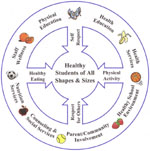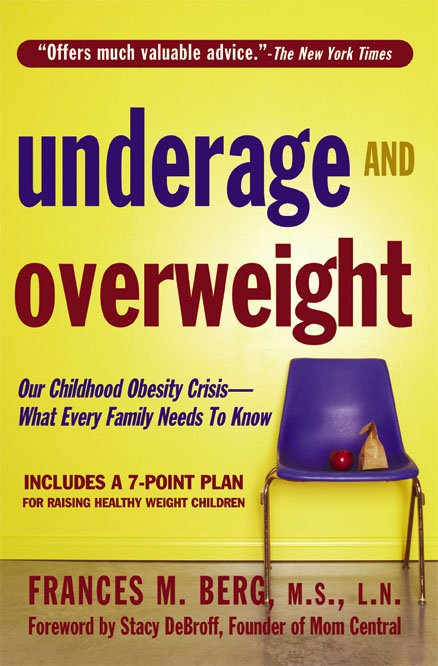| |
HEALTHY SCHOOLS
School Wellness Plans |
Crisis grows in schools
Sound school prevention programs recognize that overweight, eating disorders, widespread female undernutrition, nutrient deficiencies, dangerous weight loss efforts and size harassment are not separate issues. All are interrelated. We can’t rush in to “fix” one problem without affecting others.
Thus, safe and effective overweight and obesity prevention programs will include measures to prevent related problems, including disturbed eating, malnutrition, size bias and body hatred. Harm can result if obesity prevention moves ahead without appropriate attention to these related problems.
The challenge is to develop and integrate into the school’s health program the components that can prevent eating and weight problems. Such a program can do much to stimulate students’ intellectual growth and their ability to learn.
|
Diagram: Healthy students of
all shapes and sizes
The Goal of Promoting Healthy Weight and Eating in Schools is “Healthy Students of All Shapes and Sizes” as illustrated in this diagram, with the 8 components all working together toward this goal. Michigan schools are urged to adopt this concept model to more easily visualize the meaning. TEXT | PDF |
School wellness planning
(for obesity prevention) 
How is your state handling obesity prevention? What
is happening in your school? If you don’t know, it may be wise to find out before problems begin to surface. Overzealous interventions aimed at larger kids in school can be detrimental to all students, particularly to those with disordered eating or negative body image. In the U.S., each state has the task of developing and implementing a plan for childhood obesity prevention. It is important that the selected programs support and nurture all children, and focus on the health and well being of every child – physically, mentally and socially. It is important they avoid doing harm to vulnerable children, as can easily happen when policy makers focus on overweight and fail to consider other critical areas. TEXT
Underage and Overweight, see pgs119-131, 237-247, and 314-338
Children and Teens Afraid to Eat, see pg 247-272 |
|
 Help for prevention planners Help for prevention planners
(Society Nutrition Education)
School planning groups faced with the task of developing wellness programs (or obesity and eating disorders prevention programs) can find help with the paper Guidelines for Childhood Obesity Prevention Programs: Promoting Healthy Weight in Children, available from the Society for Nutrition Education (SNE). Parents can also use the guidelines to review school policy in their state and community. Developed by nutrition professionals, the paper encourages a health-centered, rather than weight-centered, approach that focuses on the whole child. It explains how to deal with the interrelatedness of weight and eating issues in comprehensive ways that do no harm. The SNE guidelines emphasize:
- Living actively
- Eating in normal and healthy ways
- Creating a nurturing environment for all children
Recommendations address developing a healthy framework for policy, setting appropriate goals, special considerations to guard against harm, and the difficult issues of assessment and appropriate intervention. The paper is given in full at the end of the book Underage and Overweight, and can be accessed online
Paper: PDF in English
PDF in Spanish |
Weighing and Measuring Students
in School: Position Paper (North Dakota)
The North Dakota position paper discourages weighing students in schools, mainly because of the harm it can cause and its potential for known inaccuracies and misclassification of many students. Potential harm includes:
- Negative body image, which can lead to dangerous weight loss efforts, deficiencies, disordered eating and increased health risks.
- Potential lasting, detrimental effects for larger, smaller, shorter or taller students.
- Increasing judgmental attitudes and size prejudice of peers.
- Emphasizing the notion that weight, not health, is the overriding health issue.
Position paper. PDF
Executive Statement / summary. PDF |
Role of Schools in Promoting Healthy Weight
(Michigan)
An excellent state plan for schools was developed in Michigan using the goal of Healthy Students of All Shapes and Sizes, as shown in the diagram above. The Role of Michigan Schools in Promoting Healthy Weight, a 29-page consensus paper, is based on the “healthy weight concept” developed by the Michigan Advisory Council.
Three separate but related problems are addressed jointly:
• Excessive weight gain
• Social pressure for excessive slenderness and weight discrimination
• Unhealthy weight loss practices <MORE>
http://www.michigan.gov/documents/healthyweight_13649_7 |
|

Wellness policy and obesity prevention (Iowa)
School programs that focus on the healthy living, health at every size approach of wellness and wholeness are being promoted in Iowa. The Iowa policy advocates childhood obesity prevention through healthy living in five settings – home, child care, school, community and health care. Detailed guidelines are set forth in five "supplements" making up the major portion of the 45-page Iowa position paper Prevention of Child and Adolescent Obesity in Iowa. <MORE>
|
Copyright 2009-1994 by Frances M. Berg, Healthy Weight Network, Hettinger, North Dakota. All rights reserved. www.healthyweight.net |
|
HOME | NEWS BRIEFS | HEALTHY LIVING | CHILDREN | SCHOOLS | OBESITY | WEIGHT LOSS
EATING DISORDERS | CONTROVERSIES | SELF ESTEEM | QUACKERY | BOOKS | HANDOUTS
HEALTHY WEIGHT WEEK | FM BERG | LINKS | HEALTHY WEIGHT JOURNAL | SITE MAP |
| |
|

Softcover
352 pages
$19.95 |
Also accepts Visa, MasterCard, Discover and American Express.
If ordering more than 4 books, call for shipping costs.
EXCERPTS
REVIEWS
|
|
| |

Softcover
352 pages
$19.95
|
Also accepts Visa, MasterCard, Discover and American Express.
If ordering more than 4 books, call for shipping costs.
EXCERPTS
REVIEWS |
|
| |

Softcover
496 pages
$16.95
|
Also accepts Visa, MasterCard, Discover and American Express.
If ordering more than 4 books, call for shipping costs.
EXCERPTS
REVIEWS |
|
|